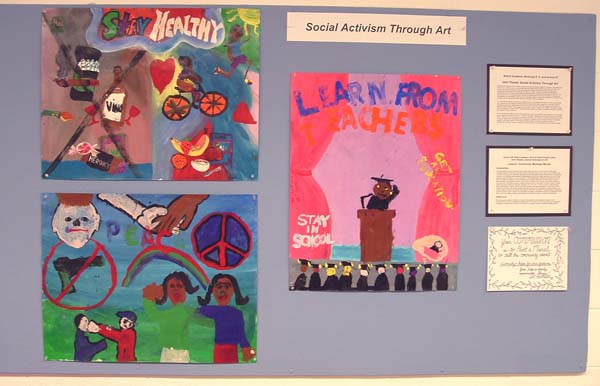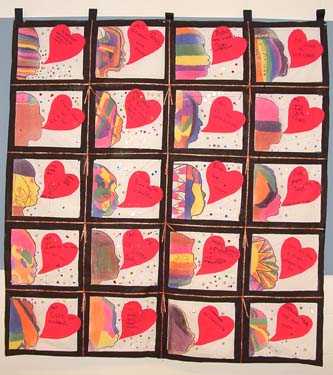Unit Theme: Social Activism Through Art
Author: Lucy Andrus

When we first began the Art Partners program with second graders at BUILD Academy, we noticed that many of our children lived in economically deprived neighborhoods where resources are lacking and families work hard everyday to make ends meet and assure the welfare of their members. We understood that adverse environmental conditions can affect children’s educational experience in challenging ways, and may create a sense of helplessness, hopelessness and passive reactivity. We also knew that art is empowering and can offer an experience ripe with opportunities for developing competency and self-esteem, gaining control through mastery of media and processes, and assuming a proactive role in responding to life experience through creative expression.
To create the foundation for this kind of experience for our students, we looked to social activist artists who use their art as a means to explore, raise consciousness, teach, respond to, and take control of important social issues affecting the community and its members. We were inspired by the work of artists like Keith Haring, Faith Ringgold, Jenny Holzer, Jacob Lawrence, Ben Shahn, the Drop-Ins, and even Michelangelo, whose Sistine Chapel paintings helped the children understand the idea of reaching the masses through public art.
What we didn’t fully realize is how meaningfully even very young children would respond to the use of art as a consciousness raising tool and a means to empower themselves and others to speak out and take action. While we could not change our students’ situations, we could offer an alternative attitude and role to play as makers and consumers of art. Art gave our students a voice in ways that were unexpected, powerful, and often poignant, particularly for those students with special needs who were not accustomed to being in control or taking a proactive position of responsibility for self as well as others.
Spring 1997 BUILD Academy, Second Grade Inclusion Class
Lesson 1: Community Message Murals

Conceptual Basis of the Lesson
As we learned more about the idea of social responsibility through art, and the ways in artists have compelled people to think about important issues, we decided to take a more active role as makers of art, ourselves. For this project, inspiration came from old and new ideas of public art that serves an educational purpose, from the Bible stories depicted in Michelangelo’s the Sistine Chapel paintings to the many social activist murals found right in our own community. From Michelangelo's experience, we learned about the idea of an artist's commission, and from viewing and discussing slides taken of various public artworks around Buffalo, we learned the power of the mural as a means to communicate an important message to the community. Six smaller groups of children were each given a commission to paint a mural on a given theme that would express an important message to the community. Themes included: health and well being, alternatives to violence, the environment, education, and hope for the future. Since these murals required a group effort, the children literally experienced activities of cooperation, consensus building, and communication in order to accomplish their goals and fulfill their commission. Perhaps equally impressive is the fact that twenty-seven children and eight adults managed to successfully use paint in a classroom space with no sink or art tables available, demonstrating the partnership needed to keep Art Partners alive!
Conceptual Basis of the Lesson
Providing opportunities for children to be part of the solution to social issues is integral to their development as productive citizens of a global world. For children who may be at risk, such experience is especially empowering in helping them move from a reactive stance to proactive problem-solving.
Spring 1997 BUILD Academy, Second Grade Inclusion Class
Lesson 2: Valentine Wishes for the World Quilt
Conceptual Basis of the Lesson
For centuries, artists have been making images of the human condition for purposes of raising awareness of important issues and encouraging social responsibility among citizens. From the drawings of Honore Daumier to the paintings of Juane Quick-To-See Smith, raising public consciousness has been the province of many an artist. The Art Partners were quick to understand these ideas during a lesson that took place around Valentine's Day. Moving beyond the usual experience of cutting and pasting valentines, the children were encouraged to expand their notions of how they might use art to express concern for others. They decided that we ought to create something that could communicate what people around the work need. Each child was asked to think of a valentine wish for the world and then express this wish by making individual quilt squares that were then sewn together with their words added in marker. Viewers may be surprised at the deeply felt concerns of our second graders who are saying things adults need to hear.

Relation to Life
Moving from learning about the self to learning about others in our world includes the need to develop empathy and concern for the human condition and in today's world, and even young children will express their awareness and concern for what goes on beyond their own small worlds of family, neighborhood, and school. The arts offer a non-threatening and creative way for children to explore their responses to what’s happening as well as share their ideas and solutions with others through large scale public works. This quilt has been exhibited in various venues in Western New York and will be posted to the Art Partners website.

Spring 2000 School 57, Elementary Special Education Class
Lesson 3: We Have a Dream for the World Quilt
Conceptual Basis of the Lesson
Art Partners takes a multicultural approach to instruction, classroom management and assessment, and infuses its curriculum year round with diversity as a general practice. However, we recognize the importance of acknowledging and honoring special cultural holidays and events that take place during the school year. Such was the case with this lesson that coincided with remembrance of Martin Luther King, Jr. What was different was having the children read about King as a child in a book by artist and author, Faith Ringgold. What we discovered is that King’s ‘dream’ began while he was still a child, just like our students. We also viewed slides and listened to the dreams of children collected form around the world. With these ideas as our inspiration, the children were asked to use images and words to express their own vision or ‘dream’ for making or the world a better place for everyone.


Relation to Life
Exploring ways in which we as individuals and as a group can make a difference in the world is an important concept to instill in people while they are children. Our pluralistic society needs and will continue to need citizens who can not only appreciate diversity but also take responsibility for helping to shape and maintain the kind of world and society that embraces all people. We need to know that all of us have something to offer and have an obligation to offer it toward the greater good. Artmaking is one way to explore these ideas and art is a powerful vehicle for effecting change, in attitude, belief and practice.